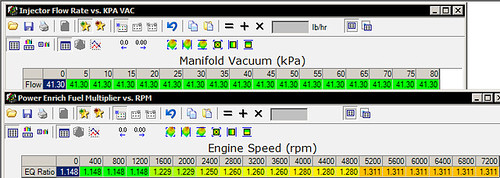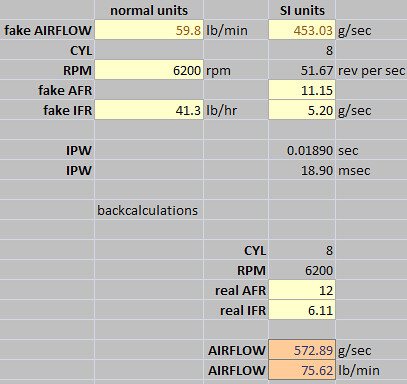Unscrewing a bad tune, Part 2
Sunday mornings are usually connected to fuzzy slippers, eggs and bacon, extra long lounging session in the tub...but not today. Barely did I sit down in front of my computer, I was asked to look at some Forced Induction tunes. The guy asking these questions was rather skeptical about the correctness of some examples he's received. Of course, the people who he got the tunes were claiming their turbo setups running well.
So I dove into one of the tunes, and all the usual marks of a bad tune were there: arbitrary IFR, untouched VE and MAF curves, super aggressive PE triggers. The whole tune was pretty much based on the PE table, assuming identical boost and airflow at the same RPM, and ignoring all other variables. The car supposedly was running well at 10psi, making me wonder if I can learn something from it. In order to do that, I decided to 'unscrew' the hacked up tune. If the measured AFR was correct, that would indicate that the final fueling decisions were made correctly, despite the wrong input data. Since this is a staple of every 'pro' tuner out there, I decided to see if it's possible to see if two wrongs can make a right.
Since the car was running in MAF mode, and the MAF signal completely maxed out by applying some healthy 10psi, I knew that the airflow figures are going to be wrong. While looking at the IFR table, I learned that the injector flow values were completely arbitrary. PE was the only real tuning device, and the resulting Pulse Width was the only non-wrong, non-fake value in the whole setup. Thus, task 1: calculate the IPW.

This part is easy, I thought. Plug in the wrong numbers, in my case 59lb/min of airflow (max'ed out MAF), 41.3lb/hr injectors, 11.15 PE value for 6400rpm which was the redline, into my VE2IPW calculator and be done. I realized that's no so easy, as my VE2IPW calculator is optimized for working with Speed Density data, not MAF. There is no field for Airflow, only its components, and Airflow gets calculated dynamically behind the scenes. I looked into the Speed Density paper for some equations, but they were no help either, as they also expected either VE, GMVE, or rho (air density), and I didn't have any of them available. If you want the hairy math details, read the updated paper. If you don't, here's a short version:
IPW=120*Airflow/(Cyl*RPM*AFR*IFR)
This means now we can calculate Pulse Width directly from the airflow number, no matter what the source of it might be, MAF or Dynamic Airflow are both fully viable sources. In the case of the hacked up FI tune I knew the car ran on maxed out MAF, so I just used the maximum value from the MAF table, 59.8 lb/hr. Few quick unit conversions and simple math operations later, I arrive at the IPW at 6400RPM: 18.9 msec.

OK, so now what? I figured I wanted to first see what the numbers would really look like if the tune was done properly. I inversed the formula to calculate the Airflow from IPW:
Airflow= IPW*Cyl*RPM*AFR*IFR/120
The big change this time I wasn't going to go with fake, ridiculous PE and arbitrary IFR. I found out what the injectors really were, calculated their flow against the fuel pressure I was told the car ran at (48.5 lb/hr). I used the AFR values from what the car supposedly ran at, 12.0AFR. Again, do some unit conversions, and out pops out the real value for airflow we should get: 576g/sec (75.6 lb/min), which is beyond the max value storable in the MAF table. So yet again, MAF being useless on Forced Induction comes out again.
Then I decided to compare this estimation of the real airflow with one of my older spreadsheets (INJsize.xls) to see how close the two are.
So I quickly punched in 8 cylinders, 5.3L (it was a truck tune), 6400rpm redline, 100%VE, and 10psi of boost. The result says 576.7 g/sec (76.1 lb/min) of airflow. That's within 1% I was happy to see consistency between the two completely different methods arriving at the same conclusion. Of course, a quick glance at the injector sizing spreadsheet pointed out that he needs almost 100% of fuel flow capacity of 48.5 lb/min injectors, and that to make it go down to 80%, he'd need to flow about 60 lb/min. Another popular myth busted--you can't run much of a FI setup on the popular 42 lb/hr (@3bar) injectors, need to step up to something bigger.

I'm posting the updated Speed Density paper HERE, and the example 'bad2good' spreadsheet HERE.
happy unscrewing bad tunes,
Marcin


0 Comments:
Post a Comment
<< Home